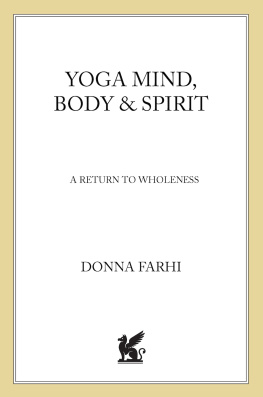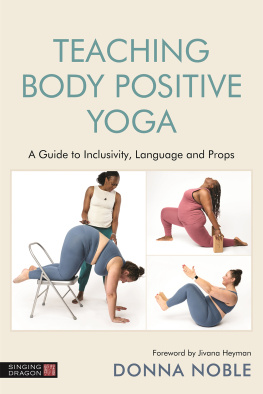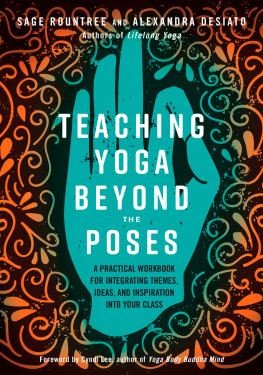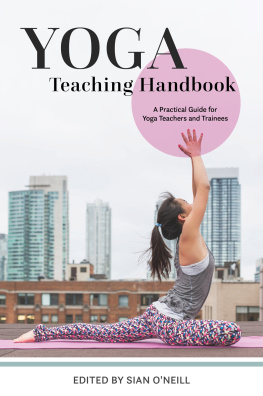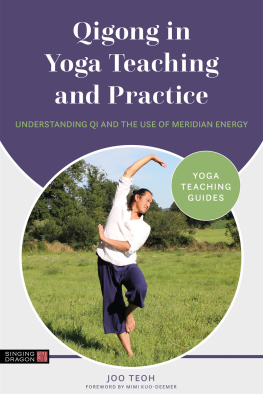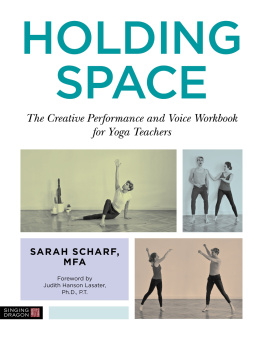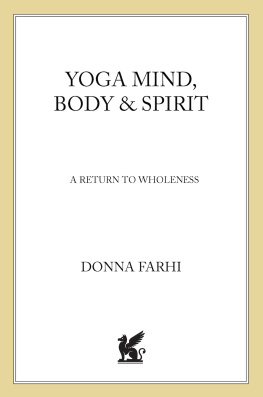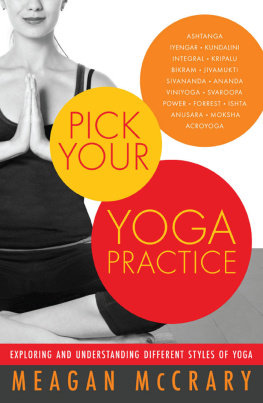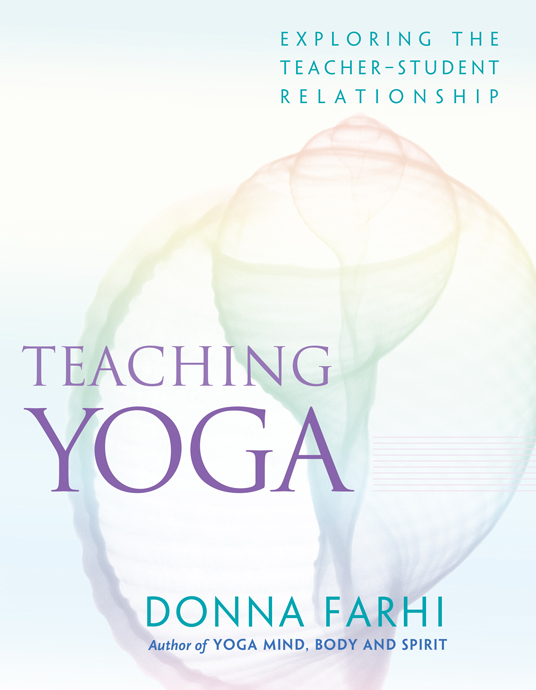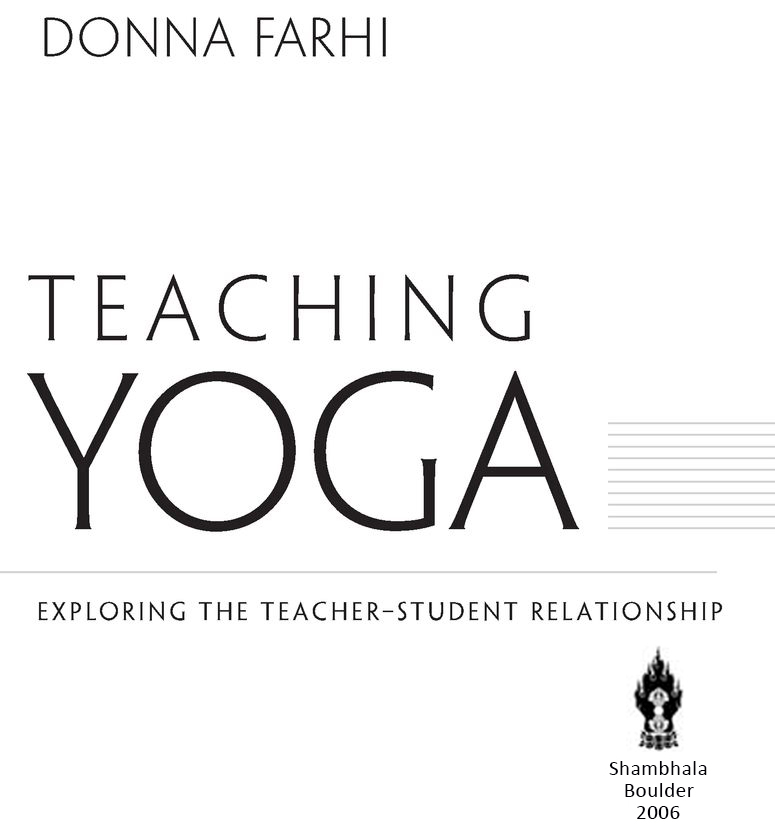Table of Contents
PRAISE FOR Teaching Yoga
I highly recommend Donnas latest offering, Teaching Yoga: Exploring theTeacher-Student Relationship. Donna has consistently worked to bring insight and awareness regarding ethical standards and violations of them within the Yoga community. My prayer is that every Yoga teacher-training program offer a course on ethics, using Donnas book as the text. Upon entering a Yoga stu- dio, students should know that this book is available as a resource and guide for ethical behavior.
Richard C. Miller, Ph. D, author of Yoga Nidra: The Meditative Heart of Yoga (book and CD)
Donna Farhi shows that teaching yoga requires both commitment to personal practice and integrity in relationships with students. Her inspiring book is an essential resource for the new generation of teachers who will carry forward this transformative lineage and impart the living experience of yoga to a world in need of healing. Highly recommended reading for anyone who loves yoga and wants to share it with others.
Greg Bogart, Ph. D., author of The Nine Stages of Spiritual Apprenticeship:Understanding the Student-Teacher Relationship
At last, here is a book that dispassionately discusses the ethics inherent in being a yoga teacher in a modern Western context. I recommend this book because it explains the psychodynamics of the teacher-student relationship in ways that show core values, such as respect and fearlessness. But I like this book because it dares to ask us hard questions about living a spiritual life, so that we can teach with clarity and compassion. An instant classic!
Judith Hanson Lasater, Ph. D., P.T., author of 30 Essential Yoga Poses: For Beginning Students and Their Teachers
Across the millennia, Yogis have recognized that the relationship between teacher and student is central to the transformational potential of yoga. And yet, in the twenty-first century, we have had little dialogue about the precise nature of this relationship. Nowat last!Donna Farhi brings us a carefully articulated examination of the complexities of teacher-student relationship. Teaching Yoga is an exquisitely crafted and important contribution to what should be a lively dialogue in the world of contemplative practice.
Stephen Cope, author of The Wisdom of Yoga: A Seekers Guide to Extraordinary Living
Wow! What a thoughtful, detailed, wonderful book. The teacher-student relationship is fundamental to the transmission and teaching of Yoga, and Donna addresses this potentially amazing relationship from many, many angles. This is a very engaging read. Donna presents the fundamental premise, treating others as you yourself would like to be treated, with sensitivity, respect, and the distilled experience of many years on the job.
Erich Schiffmann, author of Yoga: The Spirit and Practice of Moving into Stillness
BY DONNA FARHI
The Breathing Book
Yoga Mind, Body and Spirit
Bringing Yoga to Life
Teaching Yoga
TO MY STUDENTS, WHO HAVE BEEN GOOD TEACHERS.
ACKNOWLEDGMENTS
MY HEARTFELT THANKS go first and foremost to the publishers of this book, Linda Cogozzo and Donald Moyer. Their encouragement to write this book, and their support over two decades of teaching, have been instrumental in shaping my view on the importance of ethics in the Yoga community. I am thankful to all my teachers of Yoga, who each in their own way modeled what it means to be fair and kind. To my dear friend and colleague Dr. Richard Miller, thanks for standing with me. His clarity and willingness to oppose injustice within our community (even at the risk of being unpopular) has given me great solace. I am particularly grateful to the Yoga Research and Education Center for lending their superlative code of ethics to this book. Their personal and professional advice to me regarding the Yogic interpretation of values has been invaluable. Thank you to the women in the Yoga community who shared their stories, for their courage in coming forward with the truth. They gave voice to the immeasurable damage that is done when a teacher betrays a student. Their frustration, anger, and despair helped galvanize my efforts to transform my own disheartenment into positive action. It is incalculable how much my Yoga colleagues worldwide have given me through the demonstration of their own lives and through their honesty. Those who support and host my teaching visits worldwide have given me a platform from which to share the great gift of Yoga. And last, though they may seem unlikely sources of wisdom, to Braga and Tuscany (now passed) and Numen and Liberty (my current equine companions), for never failing to uncover what is unfinished and unresolved within me. It is good to have two friends who never let me get away with anything!
INTRODUCTION
I BEGAN PRACTICING YOGA at the age of sixteen, when it was offered as an elective subject at my high school in a rough part of South Auckland, New Zealand. In those days, Yoga was considered rather a bizarre practice and especially uncool for a teenager. While throngs of students signed up for ice-skating, swimming, and other alluring elective topics, a handful of misfits, myself included, showed up for their first Yoga class. My yoga teacher was actually a physical education teacher with no formal training in Yoga, other than a book, Richard Hittlemans Yoga: 28-Day Exercise Plan. She was in the last stages of her pregnancy, so the class lasted only six weeks, but by then I was totally transfixed and had already begun a daily practice at home with the help of Hittlemans book. Such was my commitment to the practice, that when the class ended, I requested that I be able to practice my Yoga alone in a tiny concrete room off the main auditorium during elective time. The principal, convinced I must be doing it as a guise to play truant, hauled me into his office one day, like the cat that had finally caught the mouse. It was only after my home-room teacher swore that Yoga was exactly what I was doing during elective time that I was able to continue undeterred.
From the very first class I was astounded to discover that such a simple practice as moving the body slowly, counting the breath, or meditating while gazing at a candle could conjure up a feeling of okayness within me. Since being moved from America as a ten-year-old girl, my childhood had been characterized by a feeling of fear, uncertainty, and isolation. I received little or no guidance from my parents and had few friends, due to a strong antiforeign sentiment in New Zealand at that time. As I moved into my teenage years, I suffered from a deep sense of depression and desperation, which eventually manifested in anorexia. Because of all these factors, my Yoga practice became a lifeline, and my time alone practicing became an oasis of sanity. Perhaps because I felt so desperately alone and alienated within a culture so unlike that of my origins in America, teachers, then and throughout my life, were to have for me a powerful guiding influence. The teachers who helped me during those first years in New Zealandthe sensitive teacher in high school who prevented me from slipping into oblivion and one special advisor at universitybecame key guides along the path. During my years studying as a dancer, there would be a special ballet mistress who, even after I had returned to the United States, came to watch me take class and give advice on my progress, though by then she was quite elderly.


